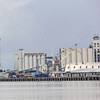The U.S could face a severe U.S.-flag tank vessel shortage unless the pace of double-hulled vessel construction increases drastically, according to an analysis released recently by the Shipbuilders Council of America. At issue is the Oil Pollution Act of 1990 (OPA 90), which requires single-hulled tank vessels to be phased out of service or converted to double-hulled vessels to reduce the risk of oil spills. Under OPA 90, the U.S. will lose as much as 28 percent of its total existing tank vessel capacity, including 45 percent of all large, ocean-going tank barges, by the end of 2004.
The analysis, which takes into account existing construction and orders, predicts that at the current rate of double hull construction, domestic tank vessel demand will exceed supply by 24 percent by the end of 2004, a key phase-out deadline.
A shortage in tank vessels would have military and commercial implications. Virtually 100 percent of all petroleum products have historically moved to war zone by waterborne transportation, and U.S. vessels are the backbone of this sealift requirement. U.S. tank vessels are also crucial to meeting America's commercial transportation needs for petroleum products.
In addition to the SCA, other maritime industry groups have raised concerns about U.S. tank vessel capacity. Recently, both the Maritime Cabotage Task Force, a powerful industry organization, and the Sealift Committee of the National Defense Transportation Association, have expressed concerns about projections of a lack of tank vessels, which would significantly diminish the nation's ability to meet its domestic transportation demands and its military sealift obligations.
In addition to double-hull construction already underway, according to the analysis, more than 500,000 dwt will need to be constructed by 2005 to simply meet growing demand for domestic waterborne transportation of petroleum products. That could equate to construction of approximately 25 20,000-dwt tank barges over the next three years.
While there has been an increase in double-hull construction, it falls far short of capacity demands in the coming years. Operators waiting until the eleventh hour to order ships could find insufficient shipyard capacity to met new building demand-a problem that could be more acute as construction in the offshore and dry cargo segments develops.
The U.S. Congress, is undertaking a more comprehensive assessment of the progress to replace the single-hulled tank fleet with double-hulled tank vessels. Its report is expected to be released shortly.
Featured videos

Inside the Electrified Truckable Tug

Tracking Foreign Vessels Working in the U.S. Jones Act Market

Inmarsat Enhances Service to Drive Digitalization
Subscribe for
Maritime Reporter E-News
Maritime Reporter E-News is the maritime industry's largest circulation and most authoritative ENews Service, delivered to your Email five times per week








